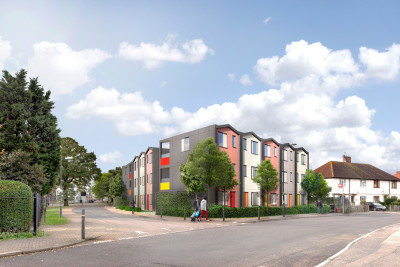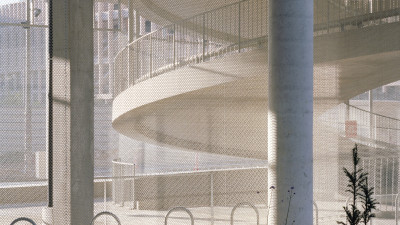What is the future of housing?
What is the future of housing?
By Helena Cuss
Published 26 October 2015
The RA’s Future of Housing season in Spring 2015 tackled issues surrounding the housing crisis. Here, we look at some of the most salient points from the debates.
-
The housing crisis in the UK has been steadily growing in recent years into a problem of national scale. In the spring, the RA Architecture programme held a series of debates and lectures that dived headfirst into the crisis’s causes, effects and possible solutions.
Here, we’ve unpicked some of the keys issues and learnings that came out of the discussions.
Click on each event to listen to the podcast.
What caused the housing crisis?
In recent years, the pitfalls of the planning system, combined with political apathy, have significantly contributed towards the housing crisis we currently face. Here, we examine the most important political, economic and social factors, which were outlined in two panel discussion held at the RA – Country, City and Suburb and Counting the Costs of the Housing Crisis.Political
• In the discussion, New Realities of Ownership, writer and curator Justin McGuirk argued that a lack of government commitment from successive governments to policy for building new homes has placed unrealistic expectations on the private sector to meet the housing demands of an ever-rising population. The political apathy to housing has been further intensified by the worldwide recession and subsequent austerity measures.• Long-term failures in the planning system have severely constrained the release of land for development in the south east.
Economic
• The political apathy to housing has been further intensified by the worldwide recession and subsequent austerity measures.• In the discussion The Psychology of Home, architect Robert Adam proposed that a lack of investment in other major UK cities outside of London has resulted in a concentration of jobs in the capital and the South-East has which has made this a highly-localised problem.
• The aforementioned developers and house builders have prioritised their own interests, building one-person properties designed to sell to overseas investors or to buy-to-let landlords who can charge extremely high rents, or sitting on undeveloped land while it accrues in value, argued Justin McGuirk.
Social
• The fad for gentrification of previously underprivileged areas, especially in south and east London, has caused considerable social change in the capital, as the young middle-class moves towards more affordable rents and thriving cultural hubs, and original residents are priced out of their homes. This point was made by London-based artist Tom Hunter and Loretta Lees, Professor of Human Geography.• Justin McGuirk noted how several large, post-war council estates such as the Heygate in London have been sold for redevelopment, but that the new housing has a much lower percentage of low income housing in the new estates, displacing thousands of people.
-
It’s not possible to locate architectural practice outside of political and social context.
Thom Holbrook, 5th Studio
-
What are the effects?
A widening gap between rich and poor to the low quality of newly built housing adversely affecting our environment and our quality of life, our expert speakers examined the short- and long-term consequences of the housing crisis. From the debates New Realities of Ownership and Upsides of Good Housing, we’ve highlighted the most prominent social and economic effects of the housing crisis.Social
• A widening gap between those on the housing ladder and those who cannot afford to get on it has created a loss of community cohesion. Furthermore, this is leading to communities becoming increasingly monocultural, with little age, racial or social diversity, argued Shumi Bose and the Guardian’s economics commentator, Aditya Chakrabortty.• In her talk, architect Sarah Wigglesworth argued that there is a lack of housing that reflects the need of the older population.
Economic
• In the discussion, New Realities of Ownership, Chris Walker (head of housing at the Policy Exchange) argued that rocketing property values have rapidly been priced young people out of the housing market and forced them into renting, property values have rocketed – property value in the UK has increased 2000% since the 1970s, compared to 0% in Germany. The crisis is further fuelled by ever-rising uncapped rent values, so those who can’t afford to buy are unable to save for a deposit.• The contributions of our audience at these discussions was hugely valued. As one audience member volunteered, homes which are being built are poor quality – being energy inefficient and poorly insulated – as most of the budget has to be spent on land purchase, leaving little money for actual building. This can result in poor standards of living and health for lower income groups, who may have to choose between heating their homes and feeding their families.
-
We were essentially told we weren't rich enough to live in our own homes.
Lindsey Garrett, Chair of the New Era Tenants Association
-

Y:Cube

Gap housing

Living Arteries

MyHouse (living room)
-
The solutions?
There are potentially imaginative and successful solutions to the housing crisis, from capping rent to encouraging architects to be socially and politically active. We heard from a host of experts. In her lecture, Mexican architect Tatiana Bilbao explored how social housing built abroad could influence the UK, while speakers at the Psychology of Home debate stressed the importance of quality even in the midst of a crisis. We’ve listed some of the best solutions to the housing crisis.• Building co-operatively owned estates would give traditional renters a way into property ownership, as well as reducing the prestige of the “cult of property” which fetishizes traditional home ownership, argued Justin McGuirk.
• Tom Holbrook, director of 5th Studio, proposed that architects need to become more socially active, lobbying Parliament for higher housing standards, to support the ideas they are already coming up with for housing.
• Moving into the greenbelt to extend suburbs or build new towns, and releasing more brownfield sites (abandoned or unused sites) for development, argued Chris Walker.
• Shaun Spiers, Chief Executive of the Campaign to Protect Rural Britain, suggested that, alternatively, further inner-city densification in London is possible, and would avoid the possibility of creating suburban slums.
• Changes in policy, such as: caps on rents and land values, a land value tax on undeveloped land, an empty homes tax, or auctioning off of long term empty homes, said designer and critic Edwin Heathcote.
• Building better quality housing in which people can emotionally invest; this involves not only the house itself, but the surrounding green environment, public spaces to encourage community growth, and local infrastructure such as amenities and transport links. This would move emphasis away from the fashion for living as close to central London as possible and encourage people to move further out where there is more space. This point was put forward by academic Nicola Dempsey, developer Roger Zogolovitch (of Solidspace) and Robert Adam. It was also proposed by architects Winy Maas and Tatiana Bilbao at their lectures.
• Custom-built homes which can be erected rapidly, are affordable, and personally customisable by prospective owners, such as MyHouse by Mae Architects (pictured), suggested Alex Ely of the firm.
• Writer Lynsey Hanley proposed a return to pre-fabricated buildings similar to those built in response to the post-WWII housing crisis, many of which are still standing today, despite originally being quick solutions.
• Identifying the variety of renters and their needs, and being imaginative about spaces which could be used: Dallas Pierce Quintero have come up with a number of creative housing ideas, such as utilising spaces in vacant offices and underused car parks for short-term housing, prefabrication units on top of existing flat roof social housing, and live-work units above high street shops.
What next?
The next few years look set to be turbulent for housing. David Cameron’s announcement of his intention to extend the right-to-buy scheme in May, indicating the Tory party’s continued emphasis on home ownership dismayed some speakers, who fear it will further diminish the country’s social housing stock, while some architects were optimistic last month over the appointment of radical leftist Jeremy Corbyn as new Labour leader, hoping that it heralds the potential return of a socially responsible state in 2020.Cameron has also recently announced his intention to scrap developer requirements for affordable housing in order to build 200,000 starter homes, a controversial move, as there are concerns that quality standards will drop significantly.
However, architects look set to take on a new role in housing, with Richard Rogers piloting his Y:Cube scheme of prefabricated houses for young homeless people in partnership with YMCA , and the enormous response to New London Architecture’s ideas competition for housing solutions, with the top ten winners set to collaborate with GLA to try and get their plans realised.
-
Demand high ceilings for breathing and thinking; ask for solid floors under your feet; reject shaky partitions!
Roger Zogolovitch, Solidspace
-

The Streets

Terrace Upcycle

Intimate Infrastructures

Community Led Intensification
-
See The Month in Architecture series to keep up to date with the biggest architecture news. See the RA’s Future of Housing season to hear about Architecture events at the RA. You can also explore our architecture podcasts, and follow the RA Architecture team on Twitter.











